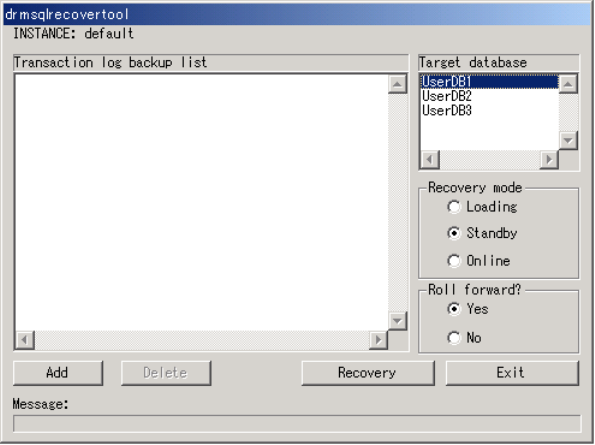HP XP7 Replication Manager Application Agent CLI Reference Guide (TK981-96014, May 2014)
Table Of Contents
- Application Agent CLI Reference Guide
- Preface
- 1 Extended commands
- Overview of extended commands
- Before reading the extended command descriptions
- Extended command specifications (File system backups)
- Extended command specifications (Common commands)
- EX_DRM_BACKUPID_SET (Generates a backup ID file)
- EX_DRM_CG_DEF_CHECK (Checks the contents of a copy-group list file)
- EX_DRM_DB_EXPORT (Exports backup information to a file)
- EX_DRM_DB_IMPORT (Imports backup information from a file)
- EX_DRM_FTP_GET (Acquires a backup information file from the backup server)
- EX_DRM_FTP_PUT (Transfers a backup information file to the backup server)
- EX_DRM_HOST_DEF_CHECK (Checks the contents of a host environment settings file)
- EX_DRM_RESYNC (Resynchronizes a copy group)
- Extended command specifications (Tape-related commands)
- Extended command specifications (SQL Server database backups)
- EX_DRM_SQL_BACKUP (Backs up an SQL Server database)
- EX_DRM_SQL_DEF_CHECK (Checks the contents of an operation definition file and automatically creates a temporary directory)
- EX_DRM_SQL_RESTORE (Restores an SQL Server database backup to the primary volume)
- EX_DRM_SQL_TLOG_BACKUP (Backs up the transaction log of the SQL Server)
- EX_DRM_SQLFILE_EXTRACT (Deploys SQL Server metafiles to the folder to be backed up to a tape device)
- EX_DRM_SQLFILE_PACK (Saves SQL Server metafiles)
- Extended command specifications (Exchange database backups)
- EX_DRM_EXG_BACKUP (Backs up an Exchange database)
- EX_DRM_EXG_DEF_CHECK (Checks the contents of an operation definition file and automatically creates a temporary directory)
- EX_DRM_EXG_RESTORE (Restores an Exchange database backup to the primary volume)
- EX_DRM_EXG_VERIFY (Verifies the consistency of an Exchange database)
- 2 Basic commands
- List of basic commands
- Before reading the basic command descriptions
- Basic command specifications (File system backups)
- Basic command specifications (Common commands)
- drmappcat (Views catalog information on a host)
- drmcgctl (Locks or unlocks a copy group)
- drmclusinit (Registers the parameters for the cluster software)
- drmdbexport (Exports backup information to a file)
- drmdbimport (Imports backup information from a file)
- drmdevctl (Conceals and reveals a physical volume)
- drmhostinfo (Displays host information)
- drmresync (Resynchronizes copy groups)
- Basic command specifications (Tape-related commands)
- drmmediabackup (Backs up data from a secondary volume to a tape device)
- drmmediarestore (Restores data from a tape device to a secondary volume)
- drmmount (Mounts a secondary volume)
- drmtapecat (Displays or deletes backup information in a backup catalog)
- drmtapeinit (Registers parameters for a backup management product)
- drmumount (Unmounts secondary volumes)
- Basic command specifications (Utility commands)
- Basic command specifications (SQL Server database backups)
- drmsqlbackup (Backs up an SQL Server database to a secondary volume)
- drmsqlcat (Displays backup information for an SQL Server database)
- drmsqldisplay (Displays or updates information for an SQL Server database)
- drmsqlinit (Registers parameters for SQL Server)
- drmsqllogbackup (Backs up the transaction log of an SQL Server)
- drmsqlrecover (Recovers restored SQL Server databases)
- drmsqlrecovertool (Recovers restored SQL Server databases via a GUI)
- drmsqlrestore (Restores SQL Server databases from backups to a primary volume)
- Basic command specifications (Exchange database backups)
- drmexgbackup (Backs up an Exchange database)
- drmexgcat (Displays backup information for an Exchange database)
- drmexgdisplay (Displays or updates information for an Exchange database)
- drmexgrestore (Restores an Exchange database backup to the primary volume)
- drmexgverify (Verifies the consistency of an Exchange database)
- 3 Support and other resources
- Index

Figure 1 drmsqlrecovertool dialog box
INSTANCE
Displays the instance name specified for the drmsqlrecovertool command. The command will
recover this instance. To change the instance, close the drmsqlrecovertool dialog box, and then
re-execute the drmsqlrecovertool command.
Transaction log backup list
Displays a list of transaction log backup files that apply to the database selected in Target
database. Use the Add button to add a file to this list. Use the Delete button to delete a file. The
files shown in Transaction log backup list are sorted each time a new file is added.
A transaction log backup file is displayed in the following format:
*file-name creation-date-and-time size
creation-date-and-time is in the yyyy/mm/dd hh:mm:ss format, and size is in kilobytes.
An asterisk (*) is added at the beginning of recovered files.
Target database
Displays the database for the instance specified for the drmsqlrecovertool command. Select the
database to which the transaction log backup files apply. You cannot select more than one database.
The maximum number of databases that can be displayed is 128. If more than 128 databases exist,
use the drmsqlrecover command to recover those databases that are not displayed.
Recovery mode
Select the state of the database after the recovery.
Loading: Changes the status of the database to loading.
Standby: Uses the database in the standby (read-only) mode.
Online: Uses the database in the read and write mode.
Database recovery is complete when the database status becomes Online. After recovery with Online
checked, no transaction logs can be applied. Before bringing the database Online, make sure that
you apply all necessary transaction logs.
Application Agent CLI Reference Guide 177










